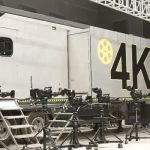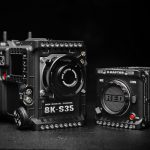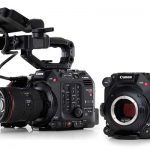RED camera specialist and DMT (data management technician) Andrew Clemson recently tested the new Mysterium-X sensor and its predecessor to visually illustrate the differences between the two. He shares his experience with BroadcastPro Middle East.

Dubai-based production house Alchemy Films, well known for its RED productions, recently took delivery of the UAE’s first RED Mysterium-X sensor. While the learning curve and inability to walk into a store to purchase it may have dissuaded some initial RED users from investing further, some like Alchemy have struck gold by sticking to the RED. The production house is one of the few in the country to boast two RED cameras with all related accessories to take full advantage of the camera’s 4K resolution and the rest of the upgrade advantages it offers.
While the production house waits for the newest RED EPIC cameras that it has ordered, it has received a new upgrade for the existing RED ONE camera, which promises to “bridge” the gap.
“The base Epic cameras promise to deliver 5K resolutions at speeds of 120fps, and RED claims the modular system will eventually have optional resolutions of up to an unimaginable 28K by swapping out the “brain” of the cameras,” explains Clemson.
“All of this comes with an option to trade in the original RED-ONE for a full refund of the cost of the body, summing up RED’s motto, of making ‘obsolescence obsolete. In the meantime, RED owners now have the opportunity to upgrade their cameras for a small cost to the new Mysterium-X sensor, the same as that found in certain flavours of the upcoming EPIC cameras.”
While the sensor will not allow the RED ONE to shoot at 5K, it will allow the images it records at 4 or 4.5K to be much cleaner than before, claims Clemson.
“This is main USP of the MX upgrade, one that is soon evident when you start shooting with it. The images it records are virtually noise free, even at high ASAs. Anyone who has shot with the existing RED in low light will know that pushing the sensor past ASA500 will result in noise, and needs work to clean it up in post. The new MX sensor, however, has a much lower noise floor and can be pushed much farther before the onset of noise. It has a slightly increased Dynamic Range of around 13.5 stops, and is perhaps the beginning of something to really rival the DR capabilities of 35mm film stock,” he adds.
Clemson, who has travelled to the RED headquarters in California and been trained first hand on the camera with the manufacturer’s specialists, undertook some tests at Action Filmz in Dubai to visually explain the differences.
Two RED cameras, #1793, equipped with the MX, and #2632, fitted with the older sensor were set up exactly the same, using a 50mm RED pro prime lens, set to T2.8.
“The RPP lenses will open to T1.8, but we also shot a comparison against a Canon 5DMK2 which used a 50mm Zeiss lens, and T2.8 was the common stop on both lenses,” he adds.
The studio was completely blacked out, apart from two LED Litepanels, dimmed to the lowest brightness setting, above and beside the “model” camera for the shoot.
“We shot in matching ASA increments, up to ASA2000. The older cameras are limited to ASA2000, whereas the MX sensor allows ASAs of up to 6400. These images are direct exports from the recorded R3Ds, with no sharpening or noise reduction,” explains Clemson.
The results showed that the Mysterium-X sensor performed much better at the higher ASAs. Noise was evident at 800ASA in the older sensor, but the MX images were clean all the way up to ASA2000, says Clemson.
This is, however, an extreme example, he adds.
“ASA2000 isn’t going to be necessary for anything short of a Barry Lyndon remake, but what it does enable us to do is shoot amazing quality images in low to No light situations. Documentary is a good example,” he adds.
SOFTWARE
We looked at the software next. As the RED seems to be permanently in the beta phase, software updates are constantly released to remove bugs and enhance features. The ability to shoot 4.5K in a widescreen format is one example.
“Build 30 is the release build for MX equipped cameras, although it can be installed on non-upgraded cameras, minus the sensor benefits and includes a few major differences to previous builds,” Clemson explains.
“First is the addition of the new colour science. The Previous View modes (REDspace and REC709) have been removed, and replaced with one uniform viewspace called REDcolor. There is also a new gamma setting, called, funnily enough REDgamma. The in-camera RGB histogram has been upgraded to a new style, adding “goalposts” to make it even easier to gauge exposure. Simply keep your histogram within the goalposts, keeping the “negative” as thick as possible for correct exposure,” he adds.
FLOATING LOOKUP TABLE
Better known as FLUT, this feature works by boosting the levels in an image while pinning down the highlights, so that they cannot clip, explains Clemson.
“Obviously this isn’t magic, and doesn’t mean you can raise the brightness of a clip forever, but it is pretty impressive and can help create much thicker negatives, and raise the usable areas of an image.
“It is also important to remember that applying any metadata such as ASA, colour temperature or FLUT to an image in-camera will not affect the recorded RAW image. As such, it is advisable to monitor and expose in the RAW Viewspace, unless you are 100% confident of viewing in REDcolour,” he adds.
Perhaps where these changes do work wonders is in the new software suite called REDcineX, Clemson points out.
RCX is still in a beta build, (currently B256) and is, therefore, constantly being updated.
“REDcineX is one applicaiton and it has replaced the three former free programmes from RED including RedRushes, REDcine, and REDAlert. REDcineX allows playback, first light grading, video and still exporting, and a basic editing timeline.
RCX also incorporates the older programme RocketcineX into itself, allowing users to playback 4K footage using RED’s proprietary GPU hardware acceleration card, the REDRocket,” he adds.
Alchemy’s director of photography (DoP) and owner, Nicholas Davidson, a veteran RED user claims that he knows “of no other card in the market that offers 4K, real time grading”.
“This is an incredibly powerful tool and if you have a 4K projector, you can see the whole thing in real time just like you would see it on a cinema screen. You can, of course, output it to a normal 2K monitor, which is more likely to be the case today,” says Davidson.
The RED Rocket can be rack mounted, or end users can buy enclosures to use it on set with a laptop making it portable as well. It allows realtime playback and rendering of full 4K resolution clips via HDMI or dual HD SDI. It is currently offered as part of a bundle deal when the user upgrades to Mysterium X.
“This is such a useful feature when transcoding hours of R3Ds,” explains Davidson.
“The most interesting factor is that all these software improvements work with footage shot on any of the previous builds of the camera. Opening a clip shot on build 16 in the newest version of REDcineX will allow one to apply FLUT, REDcolor and REDgamma, and while the results are not quite as good as if the footage had been shot on a MX camera, they are still very impressive,” adds Davidson.













































































